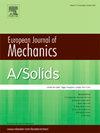Assessment of the viscoelastic and multi-axial mechanical response of POM using hypoelastic and hyperelastic constitutive models
IF 4.4
2区 工程技术
Q1 MECHANICS
引用次数: 0
Abstract
The mechanical behaviour of thermoplastics is strongly rate-dependent. One thermoplastic that is commonly used in industrial applications is polyoxymethylene (POM). In a previous paper (Mechanics of Time-dependent Materials, 2024, vol 28, p 43-63), the uniaxial tensile properties of POM were tested, and in the present study, those tests are complemented by compression tests, bending tests, and punch tests.
The test data in this study can be divided into calibration data and verification data. The calibration experiments consist of both tensile and compression tests carried out in monotonic loading, stress relaxation, and zero-stress creep. Three-point bending and quasi-static punch tests are used as verification tests. Overall, the experiments showed good repeatability, and there was a low dispersion in the experimental results.
The paper compares the performance of three constitutive models that have been developed for modelling these materials. Two hyperelastic models and one hypoelastic model are compared. The models are calibrated using the uniaxial data and then applied to the results from the more advanced tests. The material models are calibrated by utilizing commercially available optimization software.
All models have the ability to model visco-elasticity. Two of the models are network models with three visco-elastic branches/legs/phases. These two models are built in a similar way with two main novelties. The first novelty is that the stiffness can vary with the elastic deformation (in contrast to a standard neo-Hookean and Hookean model). The second novelty is that the exponent of viscous relaxation can vary with viscous deformation. The third model is an Eulerian model, meaning that all state variables are defined in the current state of the material.
Taken together, the models were able to describe the experimental results relatively well. It was concluded that they have different strengths and weaknesses. The hypoelastic model was able to describe the uniaxial calibration data best. On the other hand, this model became unstable at large deformations when simulating the punch tests. The two hyperelastic models could not model the zero-stress creep in the uniaxial tests but were able to predict the outcome from the punch tests quite well.
It was clear from the simulations that further model development is needed in order to capture all aspects of the experimental results.
使用低弹性和高弹性构成模型评估聚甲醛的粘弹性和多轴机械响应
本文章由计算机程序翻译,如有差异,请以英文原文为准。
求助全文
约1分钟内获得全文
求助全文
来源期刊
CiteScore
7.00
自引率
7.30%
发文量
275
审稿时长
48 days
期刊介绍:
The European Journal of Mechanics endash; A/Solids continues to publish articles in English in all areas of Solid Mechanics from the physical and mathematical basis to materials engineering, technological applications and methods of modern computational mechanics, both pure and applied research.

 求助内容:
求助内容: 应助结果提醒方式:
应助结果提醒方式:


